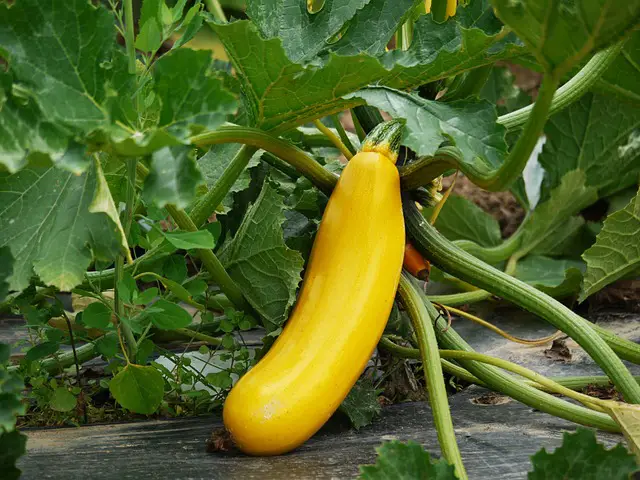Squash is a popular summer vegetable that is easy to grow in home gardens. However, many gardeners may encounter a common problem with their squash plants – yellowing leaves with brown spots.
This issue can be frustrating and concerning for gardeners, but it is important to understand the causes and potential solutions to keep squash plants healthy and thriving.
Squash leaves turning yellow with brown spots can be caused by a variety of factors, including pests, diseases, and environmental stressors. Identifying the root cause of the problem is essential to finding an effective treatment.
Some common causes of yellowing and brown spots on squash leaves include lack of water, squash bugs, powdery mildew, and downy mildew. It is important to note that different squash varieties may have specific needs and may be more susceptible to certain issues than others.
Key Takeaways
- Yellowing and brown spots on squash leaves can be caused by a variety of factors, including pests, diseases, and environmental stressors.
- Identifying the root cause of the problem is essential to finding an effective treatment.
- Different squash varieties may have specific needs and may be more susceptible to certain issues than others.
See other reasons why your plants might be having brown spots and how to remedy this:
- How to Identify and Treat Brown Spots on Snake Plant Leaves
- Small Brown Spots on Pothos Leaves
- Small Brown Spots on Philodendron Leaves
Understanding Squash Leaves
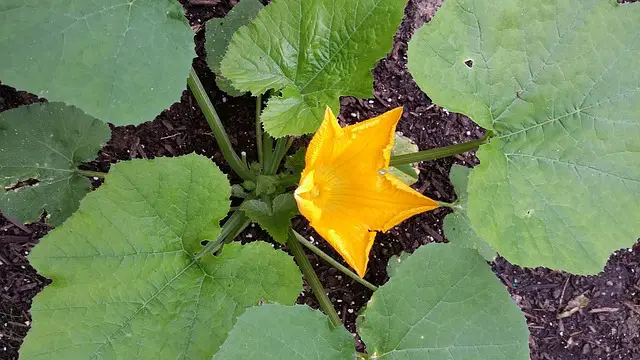
Squash plants are known for their large, green leaves that provide ample shade for the fruit. However, yellowing leaves with brown spots can be a sign of various problems that can affect the plant’s health. Understanding the causes of yellow and brown spots on squash leaves is crucial to maintaining a healthy plant.
Yellowing Squash Leaves
Yellowing of squash leaves can occur due to a variety of reasons. One common cause is a lack of water. Squash plants require consistent watering, especially during periods of drought. When the plant does not receive enough water, the leaves may turn yellow and eventually brown.
Another reason for yellowing leaves is nutrient deficiency. Squash plants require a balanced supply of nutrients, including nitrogen, phosphorus, and potassium. A lack of any of these nutrients can cause yellowing of the leaves.
Brown Spots on Squash Leaves
Brown spots on squash leaves can be a sign of fungal or bacterial infections. One common fungal disease that affects squash plants is powdery mildew. Powdery mildew can cause brown spots on the leaves and stems, as well as a powdery white coating on the leaves.
Another fungal disease that can cause brown spots on squash leaves is scab. Scab can cause angular brown spots on the leaves, which are restricted by small veins. The spots may also have yellow haloes.
Chlorophyll and Squash Leaves
Chlorophyll is the pigment that gives leaves their green color. When leaves turn yellow, it is a sign that the chlorophyll is breaking down. This can occur due to a lack of nutrients, water, or sunlight.
In some cases, yellowing of squash leaves is a natural process that occurs as the plant matures. As the plant ages, the older leaves may turn yellow and eventually fall off. This is normal and does not necessarily indicate a problem with the plant.
Squash Leaves Turning Yellow with Brown Spots – 4 Common Problems
Squash plants are an excellent addition to any garden, but they can be susceptible to various problems that can cause their leaves to turn yellow with brown spots. Identifying the cause of the problem is crucial to take the necessary steps to remedy the situation.
Here are some common causes of yellowing and brown spots on squash leaves:
1. Overwatering and Underwatering
Both overwatering and underwatering can cause yellowing and brown spots on squash leaves. Overwatering can lead to root rot infections, which can cause the leaves to turn yellow and eventually die. On the other hand, underwatering can lead to stress on the plant, causing the leaves to turn yellow and dry out.
2. Nutrient Deficiency

Iron deficiency is a common cause of yellowing and brown spots on squash leaves. Iron is an essential nutrient for plant growth, and a lack of it can cause the leaves to turn yellow and eventually die. Fertilizers can help provide the necessary nutrients to the plant.
3. Pest Infestation
Pests such as aphids, cucumber beetles, leafhoppers, squash vine borers, spider mites, and whiteflies can cause yellowing and brown spots on squash leaves. These pests can chew on the leaves, leaving behind bite marks that can cause the leaves to turn yellow and brown.
4. Diseases and Viruses
Squash plants can be susceptible to various diseases and viruses, including powdery mildew, downy mildew, squash bugs, mosaic virus, cucumber mosaic virus, and bacterial wilt. These diseases and viruses can cause the leaves to turn yellow and brown, and in severe cases, the plant may die.
It is essential to take the necessary steps to prevent and address these issues promptly. Using pesticides and fungicides can help control pest infestations and fungal diseases. Additionally, providing adequate water and nutrients to the plant can help prevent nutrient deficiency and overwatering or underwatering.
Identifying the Problem
When squash leaves turn yellow with brown spots, it can be a sign of several different issues. Identifying the problem is the first step in finding a solution. Here are some factors to consider when trying to determine what is causing yellowing leaves with brown spots on squash plants:
Nutrient Deficiencies
One of the most common reasons for yellowing squash leaves is a lack of essential nutrients, such as nitrogen, phosphorus, or potassium. These elements play a crucial role in the plant’s overall health, growth, and development.
Like all plants, squash needs certain nutrients in order to grow and produce edible squash for us to eat. If the soil is lacking in these essential nutrients, it can cause the leaves to turn yellow and develop brown spots.
Watering
Squash plants need regular watering to thrive. If the soil is too dry, the leaves may start to turn yellow and develop brown spots. Conversely, if the soil is too wet, the roots can become waterlogged, which can also cause the leaves to turn yellow. It’s important to strike a balance when watering squash plants.
Pests and Diseases

Several pests and diseases can cause yellowing leaves with brown spots on squash plants. For example, vine borers can cause yellowing of the leaves, gradually from the base end of the vine to the tip, and a small pile of “sawdust” at the base of the vine, near where it comes out of the ground.
Scab can also cause similar symptoms on leaves, stems, petioles, and fruits. Powdery mildew is another common disease that can cause yellowing leaves with brown spots.
Environmental Factors
Environmental factors can also play a role in yellowing leaves with brown spots on squash plants. For example, if the temperature is too high, it can cause the leaves to turn yellow and develop brown spots. Similarly, if the squash plant is exposed to too much direct sunlight, it can cause the leaves to burn and turn yellow.
Treatment and Prevention
Yellowing squash leaves with brown spots are a common problem for many gardeners. Fortunately, there are several ways to treat and prevent this issue.
1. Correct Watering Techniques
One of the most common reasons for yellowing squash leaves with brown spots is improper watering. Squash plants require consistent moisture, but overwatering can lead to nutrient leaching and other problems. It’s important to water the plants deeply but infrequently, allowing the soil to dry out slightly between waterings.
Using a soaker hose or drip irrigation system can help ensure consistent moisture without overwatering. Additionally, adding a layer of mulch around the plants can help retain moisture in the soil.
2. Nutrient Management
Proper nutrient management is also crucial for preventing yellowing squash leaves with brown spots. Squash plants require a balanced supply of nutrients, including nitrogen, phosphorus, and potassium. Bone meal, feather meal, and sulfate of potash are all good sources of these nutrients.
In addition to these specific nutrients, an all-organic NPK fertilizer can help ensure that the plants have access to a balanced supply of essential nutrients.
3. Pest Control
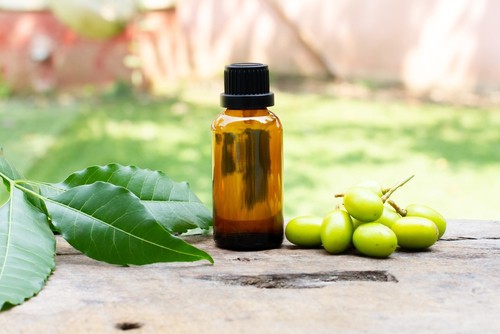
Pests can also contribute to yellowing squash leaves with brown spots. Insecticides and neem oil can help control common pests such as squash bugs and cucumber beetles. Additionally, introducing beneficial insects such as ladybugs can help keep pest populations under control.
4. Disease Management
Finally, disease management is an important part of preventing yellowing squash leaves with brown spots. Using a row cover can help prevent the spread of diseases such as powdery mildew. Additionally, removing and destroying infected plant material can help prevent the spread of disease.
Squash Varieties and Their Specific Needs
1. Summer Squash
Summer squash, including zucchini and yellow squash, are fast-growing vegetables that thrive in warm weather. These plants require well-draining soil and full sunlight, with a minimum of six hours of direct sunlight per day. They also require consistent watering, about one inch per week.
Overwatering can lead to root rot, so it’s important to avoid watering the leaves and to use a watering method that allows the soil to dry out between watering.
Summer squash plants are susceptible to powdery mildew, so it’s important to choose a resistant variety and to practice good sanitation, such as removing infected leaves and avoiding overhead watering.
2. Winter Squash
Winter squash, including butternut and spaghetti squash, are slower-growing vegetables that require a longer growing season than summer squash. These plants require well-draining soil and full sunlight, with a minimum of six hours of direct sunlight per day. They also require consistent watering, about one inch per week.
Overwatering can lead to root rot, so it’s important to avoid watering the leaves and to use a watering method that allows the soil to dry out between watering.
Winter squash plants are susceptible to squash bugs and vine borers, so it’s important to choose a resistant variety and to practice good sanitation, such as removing infected leaves and avoiding overhead watering.
3. Zucchini
Zucchini is a type of summer squash that is easy to grow and produces a large yield. These plants require well-draining soil and full sunlight, with a minimum of six hours of direct sunlight per day. They also require consistent watering, about one inch per week.
Overwatering can lead to root rot, so it’s important to avoid watering the leaves and to use a watering method that allows the soil to dry out between watering.
Zucchini plants are susceptible to powdery mildew, so it’s important to choose a resistant variety and to practice good sanitation, such as removing infected leaves and avoiding overhead watering.
4. Butternut
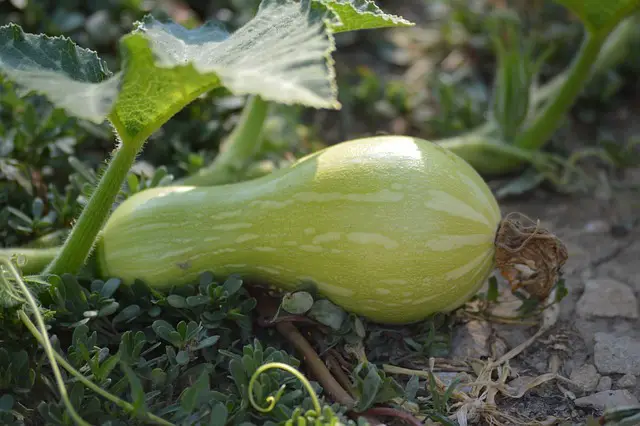
Butternut is a type of winter squash that is easy to grow and produces a large yield. These plants require well-draining soil and full sunlight, with a minimum of six hours of direct sunlight per day. They also require consistent watering, about one inch per week.
Overwatering can lead to root rot, so it’s important to avoid watering the leaves and to use a watering method that allows the soil to dry out between watering.
Butternut squash plants are susceptible to squash bugs and vine borers, so it’s important to choose a resistant variety and to practice good sanitation, such as removing infected leaves and avoiding overhead watering.
5. Spaghetti Squash
Spaghetti squash is a type of winter squash that is easy to grow and produces a large yield. These plants require well-draining soil and full sunlight, with a minimum of six hours of direct sunlight per day. They also require consistent watering, about one inch per week. O
verwatering can lead to root rot, so it’s important to avoid watering the leaves and to use a watering method that allows the soil to dry out between watering.
Spaghetti squash plants are susceptible to squash bugs and vine borers, so it’s important to choose a resistant variety and to practice good sanitation, such as removing infected leaves and avoiding overhead watering.
Gardening Best Practices
When it comes to growing squash, there are some gardening best practices that can help prevent yellowing leaves with brown spots. First and foremost, it is important to choose a suitable location for your summer garden. Squash plants require full sunlight, so choose a spot that receives at least six hours of direct sunlight each day.
Another important factor is soil health. Squash plants thrive in well-draining soil that is rich in organic matter. Consider adding natural, organic compost to your soil to improve its health. Crop rotation is also important, as it can help prevent the buildup of pests and diseases in the soil.
Proper spacing is essential for healthy squash plants. Be sure to plant your seeds or seedlings at the recommended distance apart to prevent overcrowding. This can help reduce environmental stressors, such as dehydration and competition for resources.
In addition to proper spacing, it is important to monitor the moisture levels of your soil. Squash plants require consistent moisture to thrive, but overwatering can lead to root rot and other issues. Be sure to water your plants deeply and regularly, but avoid letting the soil become waterlogged.
Finally, it is important to be mindful of environmental stressors that can impact your squash plants. Cold temperatures can damage the vascular system of the plant, leading to yellowing leaves and other issues. Blossom end rot is another common issue that can be caused by a lack of calcium or inconsistent moisture levels..
Frequently Asked Questions
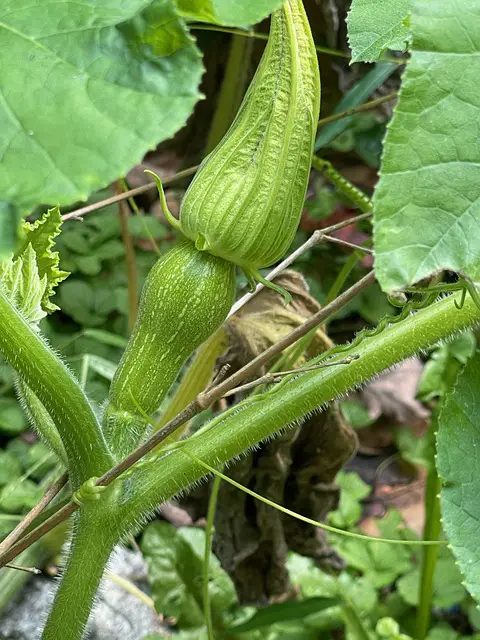
What does overwatered squash look like?
Overwatered squash plants may have yellow leaves that are soft and drooping. The leaves may also have a slimy texture and emit a foul odor. In severe cases, the plant may develop root rot, which can cause the plant to die.
How do you fix yellow leaves on squash plants?
Yellow leaves on squash plants may be a sign of overwatering, underwatering, or a nutrient deficiency. To fix yellow leaves, it is important to identify the underlying cause. If the plant is overwatered, reduce watering frequency and allow the soil to dry out before watering again.
If the plant is underwatered, increase watering frequency and make sure the soil is moist but not waterlogged. If the plant has a nutrient deficiency, add a balanced fertilizer according to the manufacturer’s instructions.
What causes brown spots on squash leaves?
Brown spots on squash leaves may be caused by a fungal or bacterial infection. Fungal infections, such as powdery mildew or downy mildew, may cause brown spots that are surrounded by a white or gray powdery substance.
Bacterial infections, such as bacterial wilt, may cause brown spots that are surrounded by a yellow halo. In some cases, brown spots may also be caused by insect damage or physical injury.
How do you save a dying squash plant?
To save a dying squash plant, it is important to identify the underlying cause of the problem. If the plant is overwatered, reduce watering frequency and make sure the soil is well-drained.
If the plant is underwatered, increase watering frequency and make sure the soil is moist but not waterlogged. If the plant has a nutrient deficiency, add a balanced fertilizer according to the manufacturer’s instructions.
In some cases, it may be necessary to remove severely damaged or infected parts of the plant.
Why are the leaves on my squash plant turning yellow?
Yellowing leaves on squash plants may be caused by overwatering, underwatering, or a nutrient deficiency. It is important to identify the underlying cause of the problem to prevent further damage to the plant. In some cases, yellowing leaves may also be caused by insect damage or physical injury.
How to treat yellowing cucumber leaves?
Yellowing cucumber leaves may be a sign of a fungal or bacterial infection, insect damage, or a nutrient deficiency. To treat yellowing cucumber leaves, it is important to identify the underlying cause of the problem.
If the plant has a fungal or bacterial infection, remove infected leaves and treat the plant with a fungicide or bactericide according to the manufacturer’s instructions.
If the plant has an insect infestation, remove the insects by hand or treat the plant with an insecticide according to the manufacturer’s instructions. If the plant has a nutrient deficiency, add a balanced fertilizer according to the manufacturer’s instructions.

Hey, I’m Lisa and I’ve been an avid gardener for over 30 years. I love writing, talking and living in the garden! Feel free to connect with me on my socials below

